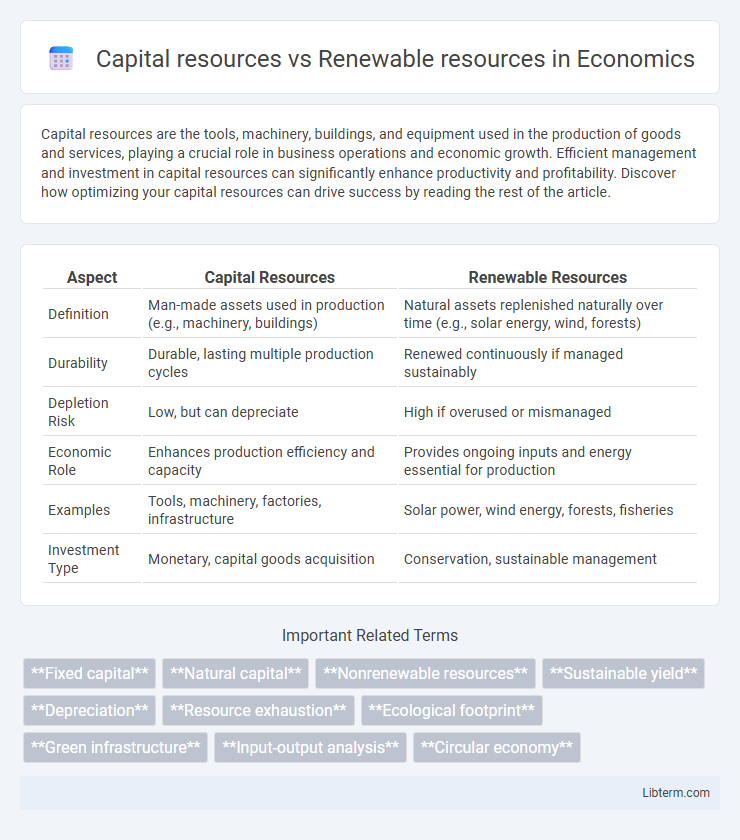Capital resources are the tools, machinery, buildings, and equipment used in the production of goods and services, playing a crucial role in business operations and economic growth. Efficient management and investment in capital resources can significantly enhance productivity and profitability. Discover how optimizing your capital resources can drive success by reading the rest of the article.
Table of Comparison
| Aspect | Capital Resources | Renewable Resources |
|---|---|---|
| Definition | Man-made assets used in production (e.g., machinery, buildings) | Natural assets replenished naturally over time (e.g., solar energy, wind, forests) |
| Durability | Durable, lasting multiple production cycles | Renewed continuously if managed sustainably |
| Depletion Risk | Low, but can depreciate | High if overused or mismanaged |
| Economic Role | Enhances production efficiency and capacity | Provides ongoing inputs and energy essential for production |
| Examples | Tools, machinery, factories, infrastructure | Solar power, wind energy, forests, fisheries |
| Investment Type | Monetary, capital goods acquisition | Conservation, sustainable management |
Introduction to Capital Resources and Renewable Resources
Capital resources consist of man-made assets such as machinery, buildings, and tools used in the production of goods and services. Renewable resources are natural assets like sunlight, wind, and water that can be replenished naturally over time. Understanding the distinction between capital and renewable resources is essential for sustainable economic development and efficient resource management.
Defining Capital Resources: Key Concepts
Capital resources refer to assets such as machinery, buildings, and tools used in the production of goods and services, distinguishing them from natural inputs like raw materials. These resources are man-made and essential for enhancing productivity and economic output. Unlike renewable resources, which are naturally replenished, capital resources require investment and maintenance to sustain their utility over time.
Understanding Renewable Resources: An Overview
Renewable resources are natural assets that replenish through ecological cycles, such as solar energy, wind, and biomass, ensuring sustainable availability over time. Unlike capital resources, which are man-made tools and machinery used in production, renewable resources provide continuous input without depletion when managed properly. Understanding the regenerative capacity and environmental benefits of renewable resources is crucial for advancing sustainable development and reducing reliance on finite capital assets.
Differences Between Capital and Renewable Resources
Capital resources refer to man-made assets such as machinery, tools, and buildings used in production, while renewable resources are naturally replenished materials like sunlight, wind, and water. Capital resources can depreciate over time and require investment to maintain or expand, whereas renewable resources regenerate continually if managed sustainably. The primary difference lies in their origin: capital resources are human-created and finite without maintenance, whereas renewable resources are naturally occurring and can be used indefinitely when properly utilized.
Importance of Capital Resources in Economic Development
Capital resources, including machinery, tools, and infrastructure, play a critical role in accelerating economic development by enhancing productivity and enabling large-scale production. Investment in capital resources drives technological innovation, increases efficiency, and creates job opportunities, leading to higher gross domestic product (GDP) growth. Unlike renewable resources, which can fluctuate due to environmental factors, capital resources provide a more stable foundation for sustained industrial expansion and economic diversification.
The Environmental Impact of Renewable Resources
Renewable resources, such as solar, wind, and biomass, offer significant environmental benefits compared to capital resources like machinery and infrastructure, which often require intensive resource extraction and energy consumption. The environmental impact of renewable resources is generally positive, as they produce little to no greenhouse gas emissions during operation and reduce dependence on fossil fuels, thereby mitigating climate change. However, the production and disposal of renewable energy technologies can involve environmental challenges, including resource mining for rare earth metals and habitat disruption.
Interrelationship Between Capital and Renewable Resources
Capital resources, such as machinery and infrastructure, enhance the efficient extraction and utilization of renewable resources like solar, wind, and biomass energy. Investments in capital resources improve the technology and processes that increase the sustainability and productivity of renewable resource use. The interrelationship between capital and renewable resources drives economic growth while promoting environmental sustainability by optimizing resource management.
Investment Strategies: Capital vs Renewable Resources
Investment strategies for capital resources prioritize long-term infrastructure and technology development to maximize asset productivity and economic returns. Renewable resource investments emphasize sustainable practices, focusing on cyclical resource replenishment and minimizing environmental impact for enduring profitability. Balancing capital and renewable resource investments enhances diversified portfolios, aligning financial growth with ecological sustainability.
Challenges in Managing Both Resource Types
Managing capital resources involves challenges such as high upfront investment costs and depreciation over time, while renewable resources demand sustainable extraction methods to prevent depletion. Balancing financial efficiency with environmental sustainability requires robust frameworks to monitor usage rates and replenish renewable supplies without compromising economic growth. Integrating advanced technologies and adaptive management strategies is critical for optimizing resource allocation and minimizing ecological impacts.
Future Trends in Capital and Renewable Resource Utilization
Future trends indicate a shift toward integrating advanced capital resources such as AI-driven machinery with renewable resources like solar and wind energy to enhance efficiency and sustainability in production. Increasing investments in smart grid technologies and automated manufacturing systems optimize the use of renewable inputs while minimizing capital depletion. Emerging innovations in energy storage and circular economy models further enable continuous, cost-effective utilization of renewable resources alongside capital assets.
Capital resources Infographic

 libterm.com
libterm.com